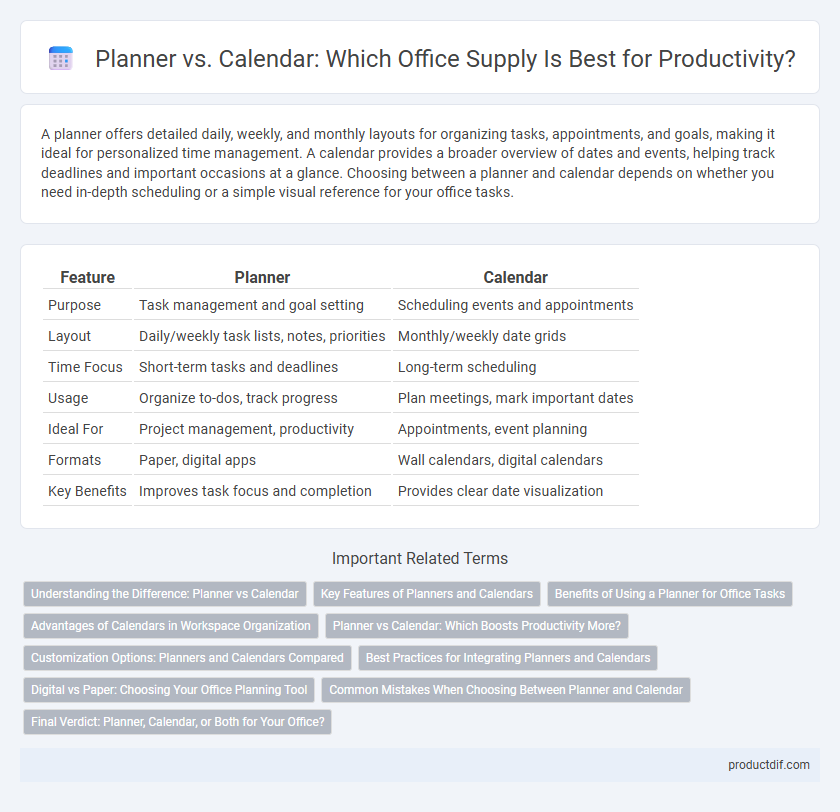A planner offers detailed daily, weekly, and monthly layouts for organizing tasks, appointments, and goals, making it ideal for personalized time management. A calendar provides a broader overview of dates and events, helping track deadlines and important occasions at a glance. Choosing between a planner and calendar depends on whether you need in-depth scheduling or a simple visual reference for your office tasks.
Table of Comparison
| Feature | Planner | Calendar |
|---|---|---|
| Purpose | Task management and goal setting | Scheduling events and appointments |
| Layout | Daily/weekly task lists, notes, priorities | Monthly/weekly date grids |
| Time Focus | Short-term tasks and deadlines | Long-term scheduling |
| Usage | Organize to-dos, track progress | Plan meetings, mark important dates |
| Ideal For | Project management, productivity | Appointments, event planning |
| Formats | Paper, digital apps | Wall calendars, digital calendars |
| Key Benefits | Improves task focus and completion | Provides clear date visualization |
Understanding the Difference: Planner vs Calendar
A planner offers a comprehensive tool for detailed daily scheduling, goal tracking, and note-taking, making it ideal for managing tasks and long-term projects. A calendar primarily focuses on date-specific events, appointments, and deadlines, providing a clear monthly or weekly overview. Understanding the difference helps optimize time management by selecting a planner for in-depth organization and a calendar for visual time tracking.
Key Features of Planners and Calendars
Planners offer detailed daily or weekly scheduling with space for notes, goals, and to-do lists, enhancing task management and time organization. Calendars provide a visual overview of dates and events, ideal for tracking appointments, deadlines, and important occasions at a glance. Both tools support productivity but serve different functions: planners for detailed planning and calendars for broad date tracking.
Benefits of Using a Planner for Office Tasks
Using a planner for office tasks enhances productivity by providing a structured layout for daily, weekly, and monthly goals, allowing for clear prioritization and time management. Planners enable detailed note-taking, task breakdowns, and progress tracking, which improve organization and reduce the risk of missing deadlines. Unlike calendars that focus primarily on dates, planners offer customizable sections tailored for project planning, meeting preparation, and task delegation critical in office environments.
Advantages of Calendars in Workspace Organization
Calendars enhance workspace organization by providing visual clarity on deadlines, meetings, and important events, which reduces scheduling conflicts and boosts productivity. They offer real-time updates and easy accessibility across devices, ensuring teams stay synchronized and informed. Integrating calendars with task management tools streamlines workflow, making project tracking and time allocation more efficient.
Planner vs Calendar: Which Boosts Productivity More?
Planners offer detailed task management with prioritization and goal-setting features that enhance daily productivity by breaking down complex projects into actionable steps. Calendars provide visual scheduling and time-blocking, ensuring efficient allocation of work hours and preventing overlapping commitments. Combining planners for task organization with calendars for time management maximizes productivity by integrating detailed planning with structured scheduling.
Customization Options: Planners and Calendars Compared
Planners offer extensive customization options including personalized layouts, goal-setting sections, and habit trackers tailored to individual productivity styles, while calendars typically provide standard date grids with limited space for notes. Digital planners enhance customization with features like color-coding, task prioritization, and integration with apps, outperforming traditional calendars in adaptability. Businesses and individuals seeking comprehensive organizational tools often prefer planners for their flexible design that supports diverse planning needs beyond simple scheduling.
Best Practices for Integrating Planners and Calendars
Integrating planners and calendars enhances office productivity by combining detailed task management with time-specific scheduling. Best practices include synchronizing deadlines from planners with calendar alerts to ensure timely follow-ups, and using color-coded categories for quick visual organization across both tools. Consistent updating and cross-referencing between planners and digital calendars minimize missed appointments and improve workflow efficiency.
Digital vs Paper: Choosing Your Office Planning Tool
Digital planners offer seamless integration with devices, real-time updates, and easy sharing, making them ideal for collaborative office environments. Paper planners provide tactile satisfaction, reduce screen time, and enhance memory retention, appealing to those who prefer physical interaction. Choosing between digital and paper tools depends on workflow preference, the need for mobility, and team coordination requirements.
Common Mistakes When Choosing Between Planner and Calendar
Choosing between a planner and a calendar often leads to common mistakes such as overestimating the need for detailed daily scheduling in a calendar or underutilizing a planner's space for notes and goals. Many users confuse the purpose of a calendar for broad date tracking with the planner's function of managing tasks and deadlines in depth, resulting in inefficient time management. Understanding the distinct features of planners, like project breakdowns, versus calendars, which emphasize date organization, helps optimize productivity and avoid scheduling errors.
Final Verdict: Planner, Calendar, or Both for Your Office?
Choosing between a planner and a calendar for your office depends on your team's workflow and project complexity. Planners offer detailed task management with priority tracking and notes, ideal for teams requiring in-depth scheduling and progress monitoring. Calendars provide a clear, visual overview of deadlines and meetings, making them perfect for quick reference and coordination, while using both can maximize organization by combining strategic planning with time-bound task tracking.
Planner vs Calendar Infographic

 productdif.com
productdif.com